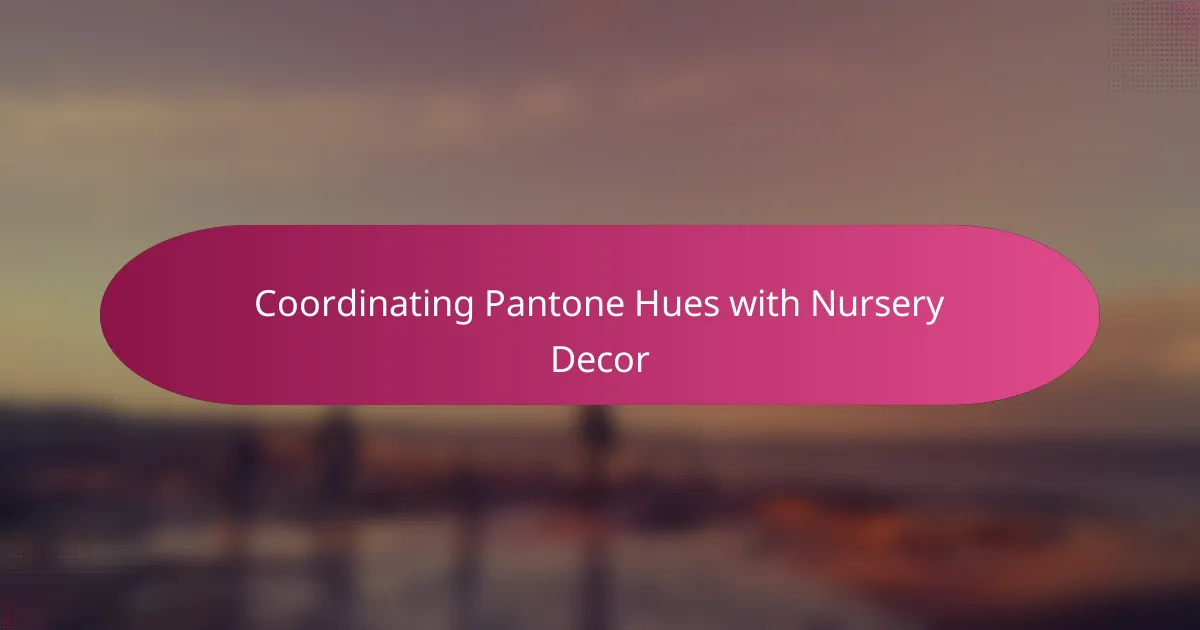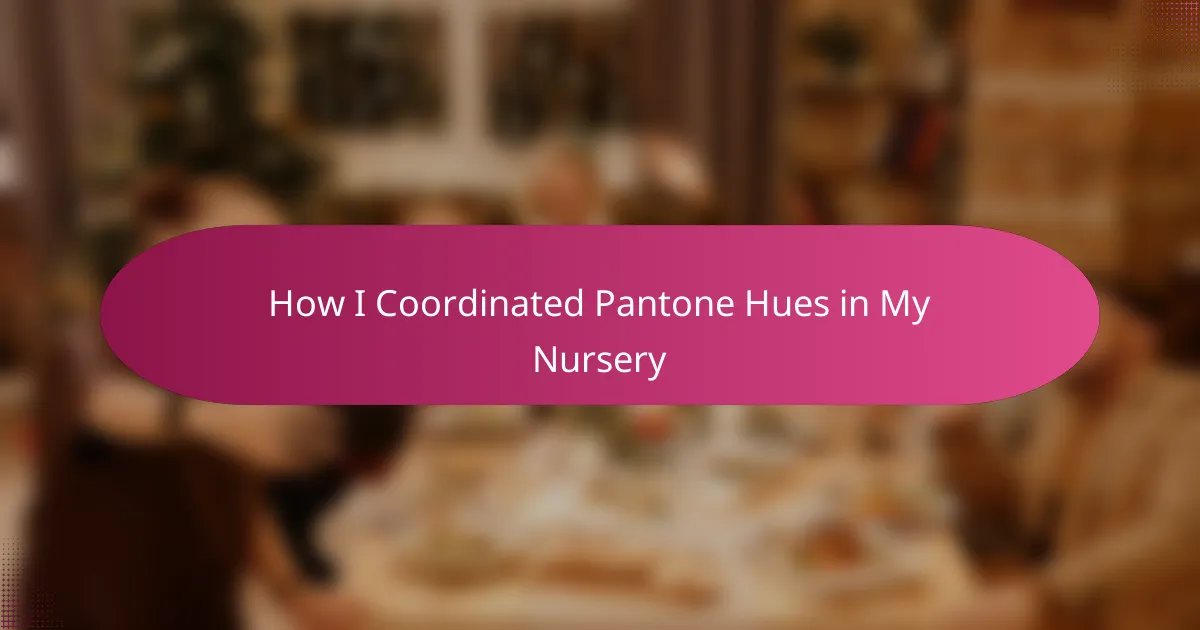Key takeaways
- Modern nursery design balances style and comfort, emphasizing simplicity and intentional color choices that promote emotional well-being.
- Pantone hues provide a universal system for color selection, enabling precise communication and emotional connection to the nursery space.
- Coordinating Pantone colors with decor ensures a cohesive and inviting atmosphere, allowing for creative combinations that enhance the nursery’s overall energy.
- Practical tips include checking colors in natural light, limiting to three core hues, and using physical swatches for accurate color matching.

Understanding Modern Nursery Design
Modern nursery design, to me, feels like striking a delicate balance between style and comfort. It’s not just about picking trendy pieces but creating a space where calm and creativity coexist. Have you ever noticed how a well-chosen shade can instantly set the mood for a room?
I’ve learned that modern nurseries focus on simplicity and functionality, which means every color, texture, and element serves a purpose. When I designed my nursery, I realized that thoughtful choices help build an environment that nurtures both the baby and the parents emotionally. It’s about more than aesthetics; it’s about feeling at ease every time you step inside.
What makes modern nursery design truly unique is its embrace of clean lines and open spaces, but with a personal touch. It invites you to express warmth without overcrowding, which is something I constantly reminded myself when selecting Pantone hues. Isn’t it amazing how a simple palette can transform a room into a sanctuary?

Introduction to Pantone Color Hues
Pantone hues have always fascinated me because they offer a precise way to capture color in its purest form. It’s like having a universal language for shades, which makes coordinating colors much less overwhelming. Have you ever struggled to find the exact tone you imagined? Pantone takes the guesswork out of that.
When I first discovered Pantone’s system, I realized it’s more than just colors on paper—it’s a tool that brings harmony to design projects. Each hue has a unique code, making it easier to communicate and reproduce consistently. This became a game-changer for me when I wanted the nursery’s colors to feel just right, every time.
What truly stood out was how Pantone hues helped me emotionally connect with the nursery space. Choosing a color wasn’t random; it was about tapping into how certain tones evoke calm, warmth, or joy. Isn’t that the kind of feeling we want in a place meant to nurture new beginnings?

Choosing Pantone Colors for Nurseries
Selecting Pantone colors for a nursery felt like embarking on a small adventure. I spent time holding swatches up to the light and imagining how each hue would gently touch the room. Have you ever been moved by how a subtle change in shade can completely alter a space’s energy? That’s exactly what happened when I settled on soft, muted tones—they instantly brought a sense of peace I knew my little one would appreciate.
I noticed that working with Pantone’s precise codes made communication with the painter so much smoother. Instead of vague descriptions like “a bit more blue,” I could say exactly which number matched my vision. This clarity saved me from second-guessing and gave me confidence in the final outcome. Isn’t it reassuring when your ideas translate just as you imagined?
What surprised me most was how certain Pantone hues felt inherently right for a nursery environment. Warm neutrals and gentle pastels didn’t just look appealing—they felt nurturing, almost like a silent hug in colors. When I reflect on the process, I realize that choosing these hues was about more than decoration; it was about crafting a backdrop that supports both growth and rest. Wouldn’t you agree that this thoughtful color selection makes all the difference?

Coordinating Pantone Hues with Nursery Decor
When I started coordinating Pantone hues with the nursery decor, I quickly found that matching the exact shades to furniture and textiles made the space feel cohesive rather than chaotic. Have you ever noticed how a slight mismatch in tones can throw off the whole vibe? Choosing a consistent Pantone palette helped me avoid that trap and created a seamless flow from wall paint to crib bedding.
I remember bringing home swatches and layering them over different materials like rugs and cushions. Seeing how the Pantone colors interacted with textures gave me a clearer sense of what the room would ultimately feel like. It wasn’t just about picking pretty colors—it was about how those colors complemented the shapes and fabrics that surrounded them, making the nursery truly inviting.
One thing I learned along the way is that coordinating Pantone hues doesn’t mean sticking to the same shade everywhere. In fact, mixing varying intensities of a particular hue brought depth and warmth to the nursery. Have you tried this? Sometimes, a subtle gradient effect between walls, curtains, and accessories can make the space feel more dynamic without overwhelming the senses.

Practical Tips for Pantone Color Application
Using Pantone colors practically means starting with good lighting. I found that checking swatches in natural daylight revealed the true character of each hue, something artificial light often masks. Have you ever painted a wall only to realize the color shifts dramatically when the sun moves across the room? That’s why I made it a point to view Pantone samples at different times of the day.
Another tip I swear by is limiting your palette to three or fewer core Pantone hues. When I first tried combining too many colors, the nursery felt cluttered instead of calm. Narrowing down my choices helped me maintain harmony and gave the space a clean, modern feel that truly nurtured relaxation. Doesn’t simplicity often lead to the most elegant results?
Lastly, I always recommend ordering physical Pantone swatches rather than relying solely on digital screens. My experience showed that monitors can distort colors, making coordination tricky. Holding the actual swatch in my hand allowed me to match fabrics and paints with confidence, which made the entire process smoother and more enjoyable. Have you tried this approach before? It’s a small step that saves a lot of guesswork.

Personal Experience Coordinating Pantone Hues
Coordinating Pantone hues felt like piecing together a colorful puzzle that was deeply personal to me. I remember the moment I matched a soft dusty rose with a creamy beige—I instantly felt a wave of calm, like the room was already hugging my baby before they even arrived. Have you ever experienced that kind of emotional connection through a simple color choice? It’s surprisingly powerful.
One challenge I faced was balancing hues that complemented each other without overwhelming the senses. I found myself revisiting my swatches multiple times, sometimes late into the evening, questioning if a tone was too cool or too warm. This process made me realize how intuitive color coordination really is—it’s about listening to what the space and your feelings are telling you. Isn’t that what thoughtful design is all about?
What surprised me most was how Pantone’s precision helped me trust my instincts with confidence. Instead of second-guessing, I could clearly communicate my vision to everyone involved in the nursery’s creation. That clarity made the entire journey less stressful and more joyful, proving that coordinating hues isn’t just a technical step—it’s a deeply emotional one too. Would you agree that confidence in your choices brings peace of mind?
